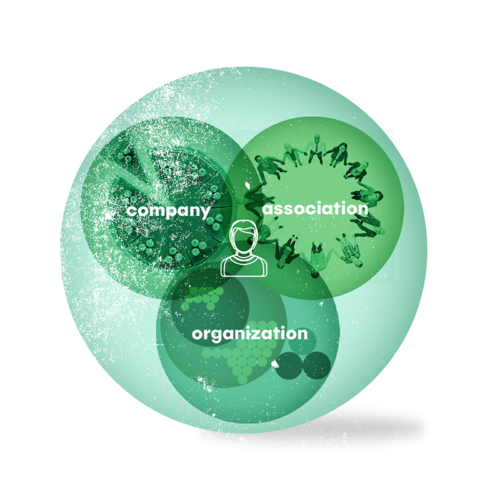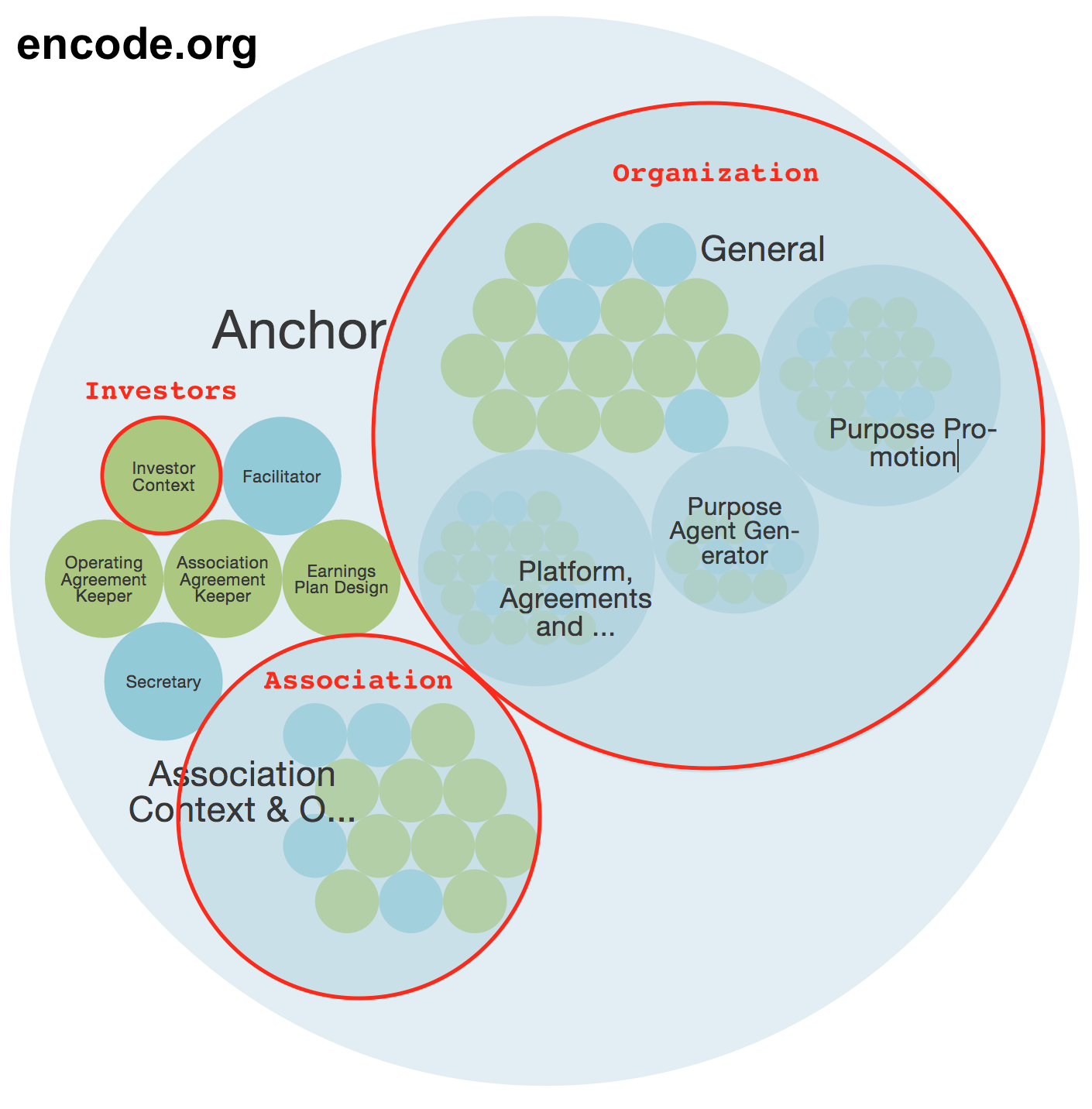By Dennis Wittrock and originally published at encode.org on medium.com
Rapidly changing business environments reward organizational agility which is achieved via decentralized decision making. Leading edge models of self-organization like Holacracy distribute authority across the organization while aligning the work with an overarching purpose. This article explores commonly perceived blind spots and criticisms of Holacracy and how the practice can be complemented by upgrading the surrounding structures to become a For-Purpose Enterprise.
The Success of Holacracy in Addressing Common Organizational Pain Points
There is a clear trend in the New World of Work pointing towards decentralization. Instead of holding on to established pyramidal power hierarchies that create organizational bottlenecks, an increasing number of companies understand that this model is hopelessly obsolete. It doesn’t scale well in a rapidly changing environment where velocity and responsiveness are key to staying competitive. The next digital disruption around the corner can be either the demise for your business or a massive opportunity for growth. It all depends on your organization’s capacity to sense and respond to what’s going on.
From this perspective it not only makes sense to distribute authority and decision-making from the center to the periphery and throughout the whole organization, it is almost mandatory. A business needs all sensing capacity of its workforce in order to sense and respond in real time. It needs clearly delineated circles, roles, and accountabilities fractally scalable in alignment with its purpose and a transparent set of rules and processes. This enables evolutionary self-organization in the light of currents needs and challenges which are constantly flowing into the event horizon of the organization from all possible directions.
After ten years of development, Holacracy as a dynamic organizational operating system has come of age as a solid solution that matches these requirements in a remarkable way. Many companies that implement Holacracy report about the advantages of increased agility, creativity, and participation while minimizing organizational waste, overhead and bottlenecks. No wonder it is spreading fast and making its rounds through the press as a wholesale replacement of the top-down command-and-control management hierarchy. Yet, there is also a lot of criticism emerging as one would expect with the level of attention and public scrutiny it is receiving.
Armchair Criticism and Criticism Coming From Practice
While “getting rid of managers” is the most click-worthy part of the story, a more nuanced understanding about the purpose of the rules of the Holacracy game encoded in its constitution is rare. After all it is a practice, not just an organizational theory. You can criticize a physician any way you want — if you are not an active practitioner of medicine yourself, the chances are high that your observations might be off the mark.
Holacracy is like medicine for the organization. You don’t have to completely get it or like it. Usually it is advisable to just do what the doctor recommends and chances are that you will feel better over time. There is a difference between armchair criticism from the outside and criticism rooted in the inside experience from practice. Both perspectives can be valid, but some form of expertise require embodiment in practice to be credible.
A Bitter Medicine

To elaborate the medical comparison a little further, one could say that Holacracy is a bitter medicine. Taking it evokes all kinds of resistance and antibodies, mostly caused by human and organizational inertia.
It is an entirely new ballgame which turns many things upside down and takes effort and practice to learn to play well.
Some people need to wake up and train their atrophied participation muscles, while former managers will have to unlearn their micromanaging habits. Real change is hard work.
Issues with Holacracy
None of this is meant to invalidate all criticism of Holacracy practice in one big blanket statement. There are legitimate concerns and issues observed, both from practitioners and non-practitioners, that Holacracy itself does not address—and wasn’t designed to address. I would like to review a few of them here.
“Rigidity” or “Discipline” and What About the People?
The first concern that is often raised is that the rule-set is overly complex and rigid. Some people have an allergic reaction to the tension-processing discipline in meetings and get the sense of the process as being cold, mechanistic, and not addressing their personal needs. Holacracy is very supportive and useful if you have an issue concerning work that is related to the organizational purpose, but if you “only” try to address your own personal item it swiftly excretes it out of its digestive process. While this makes it super-fast and effective, it means that Holacracy simply puts the ball back in our court to deal with our personal stuff outside of the organization’s processes.
Of course humans are not robots and not everybody can handle this gracefully. So if the company culture is not overly compassionate and no other forum is in place where I can be seen and heard with my human needs, it can erode my willingness to bother learning and playing this complex new game relatively quickly.
Humans still matter, which is why it is recommended to consciously steward the interpersonal space after role and soul have been differentiated through Holacracy practice.
Holacracy offers very little guidance on this, but to be fair it doesn’t claim to address this in the first place. Here’s where the expectations and projections of the critics onto the practice are misguided. Holacracy wasn’t designed to resolve interpersonal issues — even though it sorts a lot of the drama out by clarifying role expectations.
Ownership and Legal Constructs
Another factor that can make the practice of Holacracy potentially unsustainable is the fact that Holacracy remains mute on the legal foundations, the ownership construct, and the compensation model of the company that chooses to implement it. Typically, the current power holder (singular or plural, male or female), usually the founder, owner or board, cedes his authority by signing the constitution, thereby pledging to play by the rules and not exert undue power in the operational processes of the organization (e.g. through micro-managing).
But at another level the ratifier of the constitution still retains the personal power to withdraw his legitimization of the organization’s ruleset. Like a deus ex machina exercising his powers of divine intervention he can pull the plug on Holacracy at any point in time and completely twist the plot. This differential of owners vs. non-owners, employers vs. employees perpetuates traditional power patterns and continues to distort human-to-human discourse and interaction among free and equal co-workers in subtle or not-so subtle ways by creating privileged and unprivileged classes of people (check out the work of Foucault to get an idea).
Additionally, the available legal constructs in most jurisdictions run counter to the principles of self-organization and distributed authority.
Hence, even the most progressive founders who absolutely adore Holacracy have to choose antique legal containers that perpetuate the old patterns of employers / employees, ownership and can’t prevent outside investors from pulling the plug on the Constitution.
Introducing Holacracy Top-Down Contradicts Self-Management
Holacracy deployed within structures of employment becomes somewhat self-contradictory. In a way ‘freedom is being forced upon you against your will’. If not everybody is completely on board with implementing the complex rule-set, it can be experienced as having to follow a top-down order by the boss (albeit the last one) — or leave the company.
Both, the act of ‘imposing’ Holacracy and the act of ‘pulling the plug on it’ are artefacts of personal power-holding which is encoded by default in legacy legal structures of companies — even if we had the most well-meaning CEO, board-members or investors.
Compensation Needs to be Reinvented

Compensation remains a delicate issue. Holacracy doesn’t prescribe any particular compensation system. It only provides the ruleset that allows you to build and evolve whichever system you please to try on. HolacracyOne itself proposes an “app” called “badge-based compensation” which aligns with the dynamic steering principles that Holacracy is infused with. Will it work for you? It comes with no guarantees, so good luck. Finding a fair model of compensation is extremely important to gain and retain a talented workforce which in turn is crucial in success or failure as a business.
All of the previous points are in no way meant to deny the tremendous value that Holacracy brought into the world by decentralizing authority and enabling self-organization in pursuit of organizational purpose.
Rather, we at encode.org perceive them as natural evolutionary tensions that come to the foreground with a mature practice of Holacracy: differentiating the organization from the people.
The impulse that gave rise to encode.org is the curiosity to explore what’s next and to address the lingering tensions of self-organization from a higher vantage point.
How the For-Purpose Enterprise Can Help

We have developed and implemented the model of the For-Purpose Enterprise as a response to fill some of the legal, financial, and social gaps that companies using Holacracy (or other explicit rulesets of self-organization, e.g. Sociocracy) are facing. It is comprised of three containers that have their own rulesets and agreements which seamlessly tie into each other to build a differentiated whole, anchored in the corporate legislation of your local jurisdiction. These containers are Organization, Company and Association.
Organization: Where the Work Gets Done
There is no surprise in the sphere of the Organization: The preferred ruleset is still the Holacracy Constitution which defines how the work is being done. It encodes tactical operations and governance processes, as well as all the ways the purpose of the organization can be broken down into circles, roles and accountabilities to get the job done. So far, so good. The work part is covered with a brilliant system of evolutionary self-organization. It is the other containers that need to be brought up to speed to the 21st century as well.
Association: People Matter(s)
 When you practice Holacracy, you are forced to differentiate between role and soul. Since the roles are at home in the Organization, we need to find a corresponding home for the people, too. This we call the Association space. It encompasses all the human aspects, our belonging needs, our culture, our values, our ethics, etc. Here we can show up as we are, outside of role, taking care of ourselves and each other in various ways, giving and receiving personal feedback, mentoring each other, forming special interest guilds and—most importantly—friendships. Here we can relate to each other as free and equal Purpose Agents who flock together to express a shared purpose that overlaps with our individual purpose. Finally, there is a defined space for processing of personal and interpersonal tensions that fall through the cracks of the Holacracy processes. We currently encode a minimally sufficient version of expected values and behaviors in our Association Agreement that everyone agrees to upon entering.
When you practice Holacracy, you are forced to differentiate between role and soul. Since the roles are at home in the Organization, we need to find a corresponding home for the people, too. This we call the Association space. It encompasses all the human aspects, our belonging needs, our culture, our values, our ethics, etc. Here we can show up as we are, outside of role, taking care of ourselves and each other in various ways, giving and receiving personal feedback, mentoring each other, forming special interest guilds and—most importantly—friendships. Here we can relate to each other as free and equal Purpose Agents who flock together to express a shared purpose that overlaps with our individual purpose. Finally, there is a defined space for processing of personal and interpersonal tensions that fall through the cracks of the Holacracy processes. We currently encode a minimally sufficient version of expected values and behaviors in our Association Agreement that everyone agrees to upon entering.
Needless to say, the Association as inter-subjective field is always present as a layer in the background — even when we mainly work and act from role.
Don’t think of Organization and Association as separate boxes, rather picture them as interpenetrating realities that can be present simultaneously, yet are distinct in nature.
We don’t want to fuse them (pre-Holacracy), we don’t want to leave the human side to its own devices without stewardship (Holacracy), rather we want to hold and inhabit both dimensions consciously as differentiated, yet integrated whole. The For-Purpose Enterprise gives us the language and the tools to do so.
Company: The Anchor Circle as Integration Point
How do you make sure that purpose stays the boss in a managerless organization, when there are owners and founders? How do you prevent personal power-holding from taking undue influence in the running of the business? The Company container addresses these problems by installing the mature governance and decision-making process of Holacracy right into its highest level, the so-called Anchor Circle (which is somewhat akin to a traditional board but also distinctly different).
The Anchor Circle serves as an integration point between the interests of the Organization, the investors and the Association. Each of these stakeholders is represented through a role there. Below you see a snapshot of encode.org’s structure captured in Glassfrog at a certain point in time. I highlighted the three broad contexts that the Anchor circle integrates in red.

The Lead Link of the General Circle (GC) is accountable for the Organization and gets elected among the Anchor Circle members. Its corresponding Rep Link gets elected among the GC role-fillers.
The Association Context & Operations role is there to serve and represent the needs of the Association members (e.g. on- and off-boarding, member insurances, member-meetup organization, …). Its role-filler gets elected among the Association members.
The Investor Context Link gets elected by the investors of the company to represent their interests. But in the Anchor Circle there is no mechanism of majority vote of shareholders that would allow the Investor Context Link to turn the tables and push for an agenda to abandon the pursuit of purpose in favor of the pursuit of profit maximization or abandonment of Holacracy as operating system. Theoretically, you could own 100% of the capital interest but still would not have the right to outvote any decision in a conventional majority vote way.
The interests of the investors get represented and integrated via the Investor Context Link, but they cannot run the show (unlike in conventional company boards).
There are no owners, only investors in the company.
When you legally encode a For-Purpose Enterprise, the governance method of the Anchor Circle and of the Organization are one and the same. The Operating Agreement defines its decision-making process with reference to the Holacracy Constitution and legally embeds its rules into the Anchor Circle. It replaces antiquated mechanisms with a 21st century process and gets rid of the unwanted side effects of the legacy structures.
Setting the Right Incentives — Dynamic Equity Structures
How do you get people to think and act like entrepreneurs? Give them an opportunity to become investors in the purpose and receive a slice of equity of the Company. Encode.org was bootstrapped with its members as its investors. Instead of trying to predict the perfect equity split up front and fighting over the percentages of shares later, we decided to try the dynamic equity principles of “Slicing Pie” by Mike Moyer on ourselves and directly bake them into our legal agreements.

Eighteen months after inception we triggered the end of the Dynamic Equity period, ‘baked the pie’ and dished out the slices to our members. The experiment was a success in that all members confirmed that transparently tracking contributions in time and capital and basing the equity split on that data led to an equity split and cap table that feels fair and clear. You can learn more about our experiences with this model in this article.
Earnings vs. Compensation Plans
With its Earnings Plan v1.0, encode.org moves away from the notion of traditional compensation plans. Comp-plan-thinking is deeply embedded in the way conventional and even post-conventional organizations pay people. Often even the best compensation plans tend to perpetuate unwanted dynamics stemming from employers compensating employees with carrot-stick incentives in the form of hourly or salaried wages. With its Earnings Plan, encode.org begins to break the time-for-money, cog-in-wheel mentality. A For-Purpose Enterprise can now offer its Purpose Agents (Member/Partners) earnings opportunities with short, mid and long term return on investment options.
If you are working with traditional legal structures and adopt Holacracy, you still have employees who are on payroll.
There is a dissonance between the way the work is organized and how people get paid.
In a Holacracy setting, traditional job-titles don’t exist any more and compensation is no longer tied to a static position. Earning models needs to reflect (among other things) the dynamic nature of the new world of work, the multiplicity of shifting roles, a realistic market value of the required skills, work time invested, and different levels of capacity within different ‘lines’ of professional development, while at the same time cultivating Purpose Agent-Partner autonomy, mastery, and alignment. Our Earnings Plan v1.0 is an aggregate of all these factors and bears some semblance to HolacracyOne’s Badge-Based-Compensation App while attempting to stay minimally sufficient in its definitions. There is no doubt that it will continue to evolve over time.
Opting in to For-Purpose Enterprises Running with Holacracy
The most conducive context for using Holacracy is one of non-coercion. At encode.org we’re building such a context with the For-Purpose Enterprise and Purpose Agents who are not employees, but freely associated members/investors (filing a K-1 instead of a W-2 in the US tax system). Nobody is forced to join and if Holacracy doesn’t work for you, you can leave any time to find a different organization, or build your own model that better suits your needs.
. . . .
When you are new to it, it is difficult to wrap your head around the practice of Holacracy. Everything changes compared to traditional management and control systems. After ten years of cherishing, living, and breathing this new way of working, it is time to account for some of Holacracy’s limitations by plugging it into a more encompassing context more conducive to its spirit.
We believe that the For-Purpose Enterprise has the potential to catalyze the next (r)evolutionary wave of working differently — a world in which Purpose is the new boss and independent Purpose Agents organically flock around the causes that truly matter to them, with structures, rules and agreements to enable working, earning, and living for-purpose. Join us!
If you feel inspired to join in this exciting exploration sign up for Encode’s newsletter here. If you would like to learn more about the For-Purpose Enterprise and all the ways encode.org can help your organization to create optimal frameworks and conditions for the deployment of Holacracy, feel free to contact encode via their website anytime.
Republished with permission of the author.




